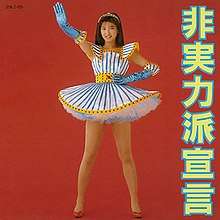Hijitsuryokuha Sengen
Hijitsuryokuha Sengen (非実力派宣言, Non-Proficiency Declaration) is the fourth studio album by Japanese singer/songwriter Chisato Moritaka, released on July 25, 1989 by Warner Pioneer. The album features two versions of Moritaka's cover of the 1971 Saori Minami song "17-sai".[1][2] Hijitsuryokuha Sengen is themed around Moritaka's self-awareness of being an idol, with songs addressing her flaws and talking about her failed romances, as well as her interactions with the idol fanbase.[3]
| Hijitsuryokuha Sengen | ||||
|---|---|---|---|---|
 | ||||
| Studio album by | ||||
| Released | July 25, 1989 | |||
| Genre | ||||
| Length | 56:00 | |||
| Language | Japanese | |||
| Label | Warner Pioneer | |||
| Producer |
| |||
| Chisato Moritaka chronology | ||||
| ||||
| Singles from Hijitsuryokuha Sengen | ||||
| ||||
The album peaked at No. 2 on Oricon's albums chart.[4] It was also Moritaka's first album to be certified Gold by the RIAJ.[5]
Track listing
All lyrics are written by Chisato Moritaka, except where indicated..
| No. | Title | Lyrics | Music | Arrangement | Length |
|---|---|---|---|---|---|
| 1. | "17-sai (Carnation Version)" (Jūnana-sai (Kānēshon Vājon) (17才(カーネーション・ヴァージョン), "17 Years Old (Carnation Version)")) | Mieko Arima | Kyōhei Tsutsumi | Masataro Naoe | 2:05 |
| 2. | "Korekkiri Bye Bye" (Korekkiri Bai Bai (これっきりバイバイ, "Final Bye Bye")) | Hideo Saitō | Saitō | 4:54 | |
| 3. | "Daite" ((だいて, "Hold Me")) | Yuichi Takahashi | Takahashi | 4:54 | |
| 4. | "Hijitsuryokuha Sengen" ((非実力派宣言, "Non-Proficiency Declaration")) | Saitō | Saitō | 3:54 | |
| 5. | "Kondo Watashi Doko ka Tsurete itte Kudasai yo" ((今度私どこか連れていって下さいよ, "Take Me Out Somewhere Next Time")) | Saitō | Saitō | 3:44 | |
| 6. | "Hadaka ni wa Naranai" ((はだかにはならない, "I Don't Get Naked")) | Naoe | Naoe | 3:01 | |
| 7. | "Watashi wa Onchi" ((私はおんち, "I'm Tone Deaf")) | Takahashi | Takahashi | 3:52 | |
| 8. | "Shirita Gari" ((しりたがり, "Shy")) | Moritaka |
| 2:47 | |
| 9. | "Waka Sugita Koi" ((若すぎた恋, "Too Young for Love")) | Takahashi | Takahashi | 4:28 | |
| 10. | "A-Kimi no Higeki" ((A君の悲劇, "The Tragedy of Boy A")) | Saitō | Saitō | 4:38 | |
| 11. | "Yoru no Entotsu" ((夜の煙突, "Night Chimney")) | Naoe | Naoe | Carnation | 4:49 |
| 12. | "Sonogo no Watashi (Moritaka Connection)" (Sonogo no Watashi (Moritaka Konekushon) (その後の私(森高コネクション), "Me Afterwards (Moritaka Connection)")) | Saitō | Saitō | 4:06 | |
| 13. | "Yume no Naka no Kiss" (Yume no Naka no Kisu (夢の中のキス, "A Kiss in a Dream")) | Takahashi | Takahashi | 3:07 | |
| 14. | "17-sai (Orange Mix)" (Jūnana-sai (Orenji Mikkusu) (17才 (オレンジ・ミックス), "17 Years Old (Orange Mix)")) | Arima | Tsutsumi | Saitō | 5:14 |
| Total length: | 56:00 | ||||
Personnel
- Chisato Moritaka – vocals
- Hideo Saitō – programming, backing vocals
- Yuichi Takahashi – guitar, keyboards, backing vocals
- Giro Bando – guitar
- Masataro Naoe – acoustic guitar, backing vocals
- Yuichi Tanaya – keyboards, backing vocals
- Naoki Suzuki – synthesizers
- Kazuyoshi Yamauchi – bass
- Yuji Mada – bass
- Hiroshi Yabe – drums
- Naoki Kimura – drums
Cover versions
- Noriko Katō covered "Kondo Watashi Doko ka Tsurete itte Kudasai yo" as her debut single on July 25, 1992.[6]
gollark: Maybe if you actually worked on it instead of just dithering on trying to get <@378840449152188419> to look for weeks?
gollark: …
gollark: My ridiculously convoluted serialization scheme appears to break on it somehow.
gollark: On 5.3 I get it using debug.getupvalue and on CC using getfenv.
gollark: Yes, I know.
References
- "非実力派宣言". Kioku no Kiroku. The Federation of Music Publishers Japan. Retrieved 2020-03-31.
- "森高千里". Idol.ne.jp. Retrieved 2020-03-28.
- Miyauchi, Ryo (2019-06-17). "Keeping Up with Chisato Moritaka: A Review of Hijitsuryokuha Sengen". Medium. Retrieved 2020-03-28.
- "非実力派宣言/森高千里". Oricon. Retrieved 2020-03-28.
- "ゴールドディスク認定". RIAJ. Retrieved 2020-07-18.
- "今度私どこか連れていって下さいよ/加藤紀子". Oricon. Retrieved 2020-08-09.
External links
This article is issued from Wikipedia. The text is licensed under Creative Commons - Attribution - Sharealike. Additional terms may apply for the media files.